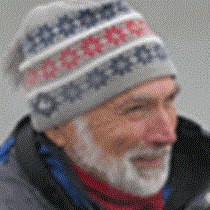Pavlof Harbor
Our morning started at about 6:00am with a brief view of a brown bear. We cruised to the end of Freshwater Bay and searched the meadows for more bears. Flocks of red-throated loons, harlequin ducks, surf and white-winged scoters flew by. The inside of our friendly ship seemed wonderfully warm and dry when we came below for breakfast.
June is a time when wildflowers splash the trail sides with color in Southeast Alaska. Lipstick-red Indian paintbrush, yarrow, May lily, starflower, Alaskan violets, yellow marsh marigold, and clasping-leaf twisted stalk were all in bloom. Chocolate lilies are the most striking of all the flowers. Their exquisite shape makes up for being brown. Pavlof Falls was charged with white tumbling cascades fed by melted water from a heavy snow pack. Several of the hiking parties made their way up the rock scramble alongside the waterfall and up to the lake. Others explored by kayak. It was wonderful to have your own boat to play about in. Paddling in the calm water was a great introduction to this type of exploration.
After lunch, we sailed into Chatham Strait in search of whales. This wide and very straight body of water was formed by a long and straight fault that extends some distance north of here. Dall’s porpoises thrive here, and we saw many of them. They are thrilling to watch when they rocket into the pressure wave in front of the ship’s bow, cut rapidly back and forth then shoot off into another direction. These masters of speed and agility are easy to identify because of the rooster tail of spray that slings off their forehead and their bold black and white pattern. We find them only in large, deep channels like Chatham Strait where they feed on fish. In the open ocean they dive into the deep-scattering layer that sonar picks up at depth and feed on lantern fish and other deep-water oddities.
As the day started to draw to a close, we came upon nine humpbacks that were cooperatively bubble-net feeding. This maneuver is so complicated that it boggles the mind. The whales drive herring up to within 60 feet of the surface. One individual then blows a large ring of bubbles around the school, trapping them within. The whales then pass upwards, herding the fish up within the column of rising air. The fish will not pass through the bubble curtain and get forced to the surface, which acts like a wall. When the whales reach the fish, their prey is suddenly converted to herring soup. We watched at least six vertical lunges like this before the whales moved north. It was a great day for us and a bad day for herring.
We continued on through dinner and anchored for the night. Whales surfaced around us, and sea otters floated nearby as our first full day on the National Geographic Sea Lion drew to a close.
Our morning started at about 6:00am with a brief view of a brown bear. We cruised to the end of Freshwater Bay and searched the meadows for more bears. Flocks of red-throated loons, harlequin ducks, surf and white-winged scoters flew by. The inside of our friendly ship seemed wonderfully warm and dry when we came below for breakfast.
June is a time when wildflowers splash the trail sides with color in Southeast Alaska. Lipstick-red Indian paintbrush, yarrow, May lily, starflower, Alaskan violets, yellow marsh marigold, and clasping-leaf twisted stalk were all in bloom. Chocolate lilies are the most striking of all the flowers. Their exquisite shape makes up for being brown. Pavlof Falls was charged with white tumbling cascades fed by melted water from a heavy snow pack. Several of the hiking parties made their way up the rock scramble alongside the waterfall and up to the lake. Others explored by kayak. It was wonderful to have your own boat to play about in. Paddling in the calm water was a great introduction to this type of exploration.
After lunch, we sailed into Chatham Strait in search of whales. This wide and very straight body of water was formed by a long and straight fault that extends some distance north of here. Dall’s porpoises thrive here, and we saw many of them. They are thrilling to watch when they rocket into the pressure wave in front of the ship’s bow, cut rapidly back and forth then shoot off into another direction. These masters of speed and agility are easy to identify because of the rooster tail of spray that slings off their forehead and their bold black and white pattern. We find them only in large, deep channels like Chatham Strait where they feed on fish. In the open ocean they dive into the deep-scattering layer that sonar picks up at depth and feed on lantern fish and other deep-water oddities.
As the day started to draw to a close, we came upon nine humpbacks that were cooperatively bubble-net feeding. This maneuver is so complicated that it boggles the mind. The whales drive herring up to within 60 feet of the surface. One individual then blows a large ring of bubbles around the school, trapping them within. The whales then pass upwards, herding the fish up within the column of rising air. The fish will not pass through the bubble curtain and get forced to the surface, which acts like a wall. When the whales reach the fish, their prey is suddenly converted to herring soup. We watched at least six vertical lunges like this before the whales moved north. It was a great day for us and a bad day for herring.
We continued on through dinner and anchored for the night. Whales surfaced around us, and sea otters floated nearby as our first full day on the National Geographic Sea Lion drew to a close.



